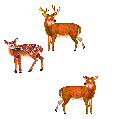
This lesson was developed as part of
my Manchester College Science Methods course. It is geared toward my third
grade student teaching placement and goes along with a social studies unit about
community. I thought this would be a great way to connect learning about
ecosystems to learning about different aspects of their community.

To start off this lesson on ecosystems, I have the students going on a field trip around their community to three different ecosystems. These ecosystems include a swamp area, a woods/forest area, and a field or grasslands area. They explore these sites using their five senses, all except for taste. Then, they answer questions about the types of animals and plants they saw and why these parts are important to that ecosystem. This activity gets them thinking about ecosystems and is a great lead in to this web quest project.
This is the Science Trail I had my class do around their community. I took the pictures of the actual places, so they knew where we would be going. You could easily adjust the places to fit areas around your school or in your community.
 Learners
Learners
This lesson is geared towards third grade students, but could be adapted to any
grade. It focuses mainly on science related information, being ecosystems
and the five senses, but I have included the community aspect of social studies.
Before completing this lesson, the students will need to have a basic understanding of how to use a computer and navigate around a website.
Standards

Science Standards Addressed
3.1.2 Participate in different types of guided scientific investigations, such as observing objects and events and collecting specimens for analysis.
3.1.5 Demonstrate the ability to work cooperatively while respecting the ideas of others and communicating one's own conclusions about findings.
3.2.6 Make sketches and write descriptions to aid in explaining procedures or ideas.

The most important outcome I have for this project is to get the students out in nature and thinking like scientist. I want them to be able to describe an object using more than just what they see with their eyes. The importance of using the five senses allows them to see something in a different view and opens their minds up to new concepts. This project was also created to help students with critical thinking, observation, comparison, teamwork, and compromise; all essential components of being successful people.

